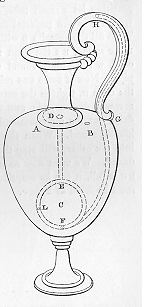The following is the construction of the vessel called a dicaeometer, which, having been filled with liquid, discharges an equal quantity every time it is inverted.
 Let A B (fig. 41), be a vessel the neck of
which is closed by the partition A B: near its bottom let there be a
small globe, C, holding the measure of water we intend to flow out.
Through the partition insert a small and very fine tube, D E,
communicating with the globe. In the lower part of the globe perforate a
small hole, F, from which a pipe, F G, extends upwards, running just
beneath, and communicating with, the handle of the vessel which is
hollow. Near the hole just mentioned make another at L towards the body
of the vessel: the handle also must have a vent at H. Having first
stopped the vent H we must fill the vessel with liquid through a hole
which must afterwards be carefully closed, or the vessel may even be
filled through the tube D E. Now, if we invert the vessel and set the
vent H free, the liquid in the globe C and the tube D E will flow out.
If we again close the vent and restore the vessel to its original
position, the globe and tube will be filled again, for the air they
contain will be driven out by the liquid rushing in; and, when the
vessel is once more inverted, a like quantity of liquid will again flow
out, except indeed with some difference as to the tube D E, for it will
not be always filled, but as the vessel grows empty it will be empty
itself: this difference however is extremely small.
Let A B (fig. 41), be a vessel the neck of
which is closed by the partition A B: near its bottom let there be a
small globe, C, holding the measure of water we intend to flow out.
Through the partition insert a small and very fine tube, D E,
communicating with the globe. In the lower part of the globe perforate a
small hole, F, from which a pipe, F G, extends upwards, running just
beneath, and communicating with, the handle of the vessel which is
hollow. Near the hole just mentioned make another at L towards the body
of the vessel: the handle also must have a vent at H. Having first
stopped the vent H we must fill the vessel with liquid through a hole
which must afterwards be carefully closed, or the vessel may even be
filled through the tube D E. Now, if we invert the vessel and set the
vent H free, the liquid in the globe C and the tube D E will flow out.
If we again close the vent and restore the vessel to its original
position, the globe and tube will be filled again, for the air they
contain will be driven out by the liquid rushing in; and, when the
vessel is once more inverted, a like quantity of liquid will again flow
out, except indeed with some difference as to the tube D E, for it will
not be always filled, but as the vessel grows empty it will be empty
itself: this difference however is extremely small.